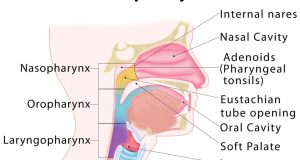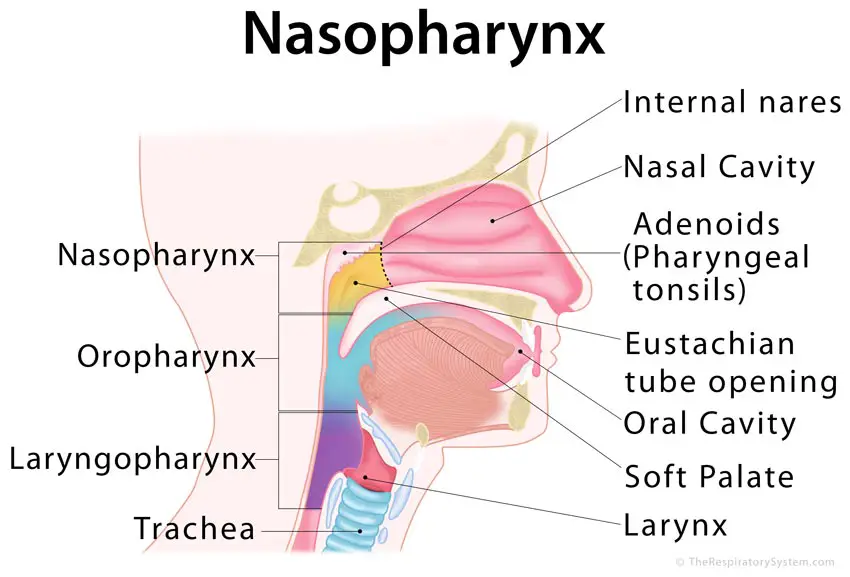Published on February 16th 2018 by admin under
What is the Nasopharynx
The nasopharynx is the first of the three sections forming the pharynx [1], the other two being the oropharynx and laryngopharynx.
Where is the Nasopharynx Located
The superior or uppermost part of the throat, the nasopharynx is the hollow space lying at the skull base [2], above the oral cavity, extending after the choanae or posterior openings of the nasal cavities [3].
Nasopharynx Structure and Anatomy
Walls and Boundaries of the Nasopharynx
In the front, it has the posterior nares and the back part of the nasal septum [4]. Inferiorly, the soft palate marks the boundary between the nasopharynx and the following section of the pharynx, oropharynx [1].
The nasopharynx is primarily lined by two types of epithelia, with the stratified squamous epithelium comprising around 60% of its inner walls [5]. The nasopharynx is also the only section of the pharynx to have pseudostratified columnar respiratory epithelium [6], the specialized epithelium (ciliated and containing goblet cells) for the respiratory tract [7]. These two epithelia have a sharp interphase between them, except for certain areas where an intermediate epithelium intervenes. The respiratory and intermediate epithelia together form the rest of the (40%) nasopharyngeal epithelium.
The adenoids, also called the pharyngeal tonsils [7] (collection of lymphoid tissues) are located in the walls and roof of the back of the nasopharynx [8], while there are small lymphocytes accumulating in various places beneath the mucous membrane [6].
Openings from the Nasopharynx
The openings to the Eustachian tubes, the two auditory tubes that serve as the channel between the middle ears and the nasopharynx are located in the center of the lateral nasopharyngeal wall [9, 4].
Blood Supply
The arterial supply is carried out by the ascending pharyngeal, palatine, facial, and cervical arteries, as well as the maxillary artery. The pterygoid and pharyngeal plexus are responsible for the venous supply to the nasopharynx [4].
Innervation
The maxillary nerve or CN V2 provides the nerve supply in this area [2].
Functions of the Nasopharynx
In Respiration: It is the part of the pharynx involved in respiration, working with the nasal cavity, larynx and the rest of the airways during breathing. Due to the presence of the ciliated respiratory epithelium, the nasopharynx also plays a role in purifying and conditioning the inhaled air [2] before letting it move further down the respiratory tract [10].
For Fighting Infections: The lymphatic tissues and adenoids in the nasopharynx function as part of the immune system, with white blood cells circulating through them to fight infections and harmful foreign particles [1, 11].
As a Drainage System: The middle ear communicates with the nasopharynx through the Eustachian tube [12], which drains all middle ear secretions into the latter. The nasopharynx also serves as the drainage channel for lymphatic fluids produced due to the purification of air, and from the functioning of the adenoids [1].
Associated Conditions
Nasopharyngeal Cancer: Also known as nasopharyngeal carcinoma, it is a rare type of cancer characterized by lumpy feeling in the neck, persistent painful or sore throat, blurry or double vision, hearing loss along with recurrent ear infections, and stuffy nose. Though its causes are not clearly known yet, it has been associated with an Epstein-Barr virus infection; however, this does not mean that the infection leads to cancer in everyone. Research is going on to find some genetic connection between EBV and the cancer [13].
References
- https://www.healthline.com/human-body-maps/nasopharynx#1
- http://teachmeanatomy.info/neck/viscera/pharynx/
- https://inside.ucumberlands.edu/academics/biology/faculty/kuss/courses/Respiratory%20system/HumanNasalPassages.htm
- https://radiopaedia.org/articles/nasopharynx
- https://www.proteinatlas.org/learn/dictionary/normal/nasopharynx
- http://www.lab.anhb.uwa.edu.au/mb140/CorePages/Respiratory/respir.htm
- http://www.siumed.edu/~dking2/crr/rsguide.htm
- https://www.ncbi.nlm.nih.gov/books/NBK238/
- http://www.elcamino.edu/faculty/rsidhu/Anat-32/Respiratory%20System.pdf
- https://study.com/academy/lesson/pharynx-anatomy-definition-quiz.html
- https://www.webmd.com/children/picture-of-the-adenoids
- https://emedicine.medscape.com/article/874348-overview
- https://www.webmd.com/cancer/nasopharyngeal-cancer#1









